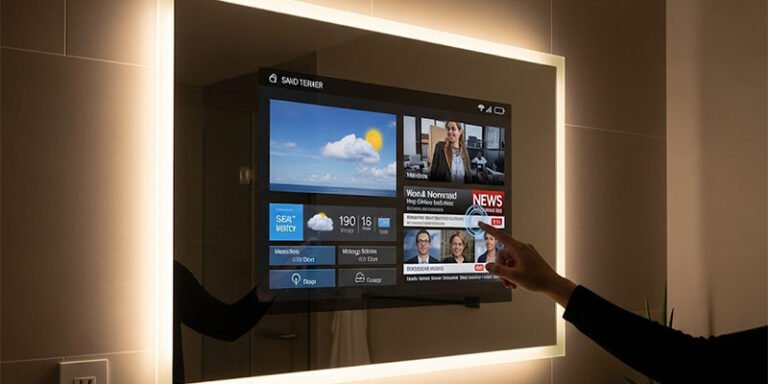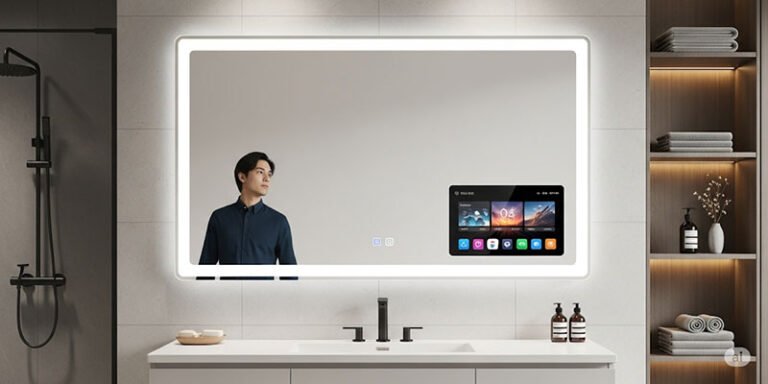Smart health mirrors are changing how people check and manage their health at home. These devices look like regular mirrors but use sensors, cameras, and artificial intelligence to scan vital signs, monitor body changes, and provide personal health insights. They offer features like full-body scans, real-time feedback, and can even connect users with healthcare professionals for remote advice.
With smart mirrors such as the Withings Omnia, users can see their health metrics—like weight, heart rate, and more—every time they look in the mirror. The technology provides instant updates using simple visuals and voice guidance, making it easy to track progress and spot any potential health concerns early.
Key Takeaways
- Smart health mirrors combine regular mirrors with health technology.
- They track key health data and give real-time feedback.
- Users can use them for both daily checks and remote healthcare.
What Are Smart Health Mirrors?
Smart health mirrors use technology to collect and show health data. These devices mix traditional mirrors with sensors and displays to help people monitor and improve their well-being at home.
Definition and Evolution of Smart Mirrors
A smart mirror looks like a regular mirror but has digital features added behind its surface. These mirrors combine a reflective glass with a screen and other hardware.
Early smart mirrors displayed simple information such as the time or weather. Over time, their uses have grown to include health tracking, reminders, and entertainment.
Now, smart mirrors in healthcare can scan vital signs, monitor skin conditions, and give health insights. Projects like the Wize Mirror aim to detect early signs of heart disease by scanning a user’s face for symptoms and trends. Smart mirrors appear in homes, hospitals, and even retail settings.
Core Components and Technologies
Smart health mirrors include several key parts:
- Reflective Surface: Semi-transparent glass allows digital information to be seen over a user’s reflection.
- Display Screen: Usually an LCD or LED, which sits behind the glass and shows data and visuals.
- Sensors: Cameras, microphones, and sometimes infrared or biometric sensors, which gather health and environment information.
- Computer Hardware: A small built-in computer or processor handles data and runs applications.
- Internet Connectivity: Most smart mirrors use Wi-Fi or Bluetooth to connect with other devices or cloud services.
Many smart mirrors use artificial intelligence (AI) to analyze data, give feedback, and recognize faces. They collect information such as heart rate, sleep patterns, skin changes, and sometimes even blood pressure.
Integration with Smart Homes
Smart health mirrors are designed to fit smoothly with other home technology. They often connect with other smart home devices, such as fitness trackers, smart scales, and voice assistants.
These mirrors let users access health data, set reminders, or control home systems using simple touch or voice commands. In a smart home, the mirror becomes a central hub for personal health and daily routines.
Some models support telemedicine, letting users have video calls with doctors from their bathroom or bedroom. This integration makes it easier to track changes, share health data, and maintain healthy habits.
Key Features and Capabilities
Smart health mirrors use advanced technology to support personal health management. Their main features are designed to provide specific health insights, daily tracking, and tailored user experiences.
Facial Recognition and User Personalization
Many smart health mirrors are equipped with facial recognition. This technology identifies individual users as soon as they stand in front of the mirror. It ensures that health data and insights are shown to the correct person, which helps protect personal privacy.
User personalization allows each family member to have a unique health profile. The mirror displays tailored reminders, coaching tips, and health measurements for each person. Artificial intelligence adds another layer, offering personalized suggestions based on patterns and habits found in collected data.
These mirrors also remember preferred settings, such as lighting or favorite display widgets, making daily use easier. Some even connect data securely to health apps, so users can track long-term trends.
Biofeedback and Sensor Technology
Smart mirrors rely on a network of sensors to monitor health without extra steps from the user. Biofeedback tools gather data on heart rate, respiration, and posture through optical and contact sensors. Many use photoplethysmography (PPG)—an optical method that measures pulse by detecting tiny changes in skin color caused by blood flow.
These mirrors often feature motion sensors to observe posture or movements during daily routines. Data from these sensors is processed by built-in artificial intelligence, helping users spot trends or changes in their health over time. Results are shown in easy-to-read graphs or reports right on the mirror’s surface.
Some models also use microphones to monitor voice patterns, alerting users to possible changes in breathing or stress.
Skin Analysis and Vital Signs Tracking
Skin analysis is a key capability in many smart health mirrors. High-resolution cameras examine skin texture, color, and hydration levels. By analyzing daily or weekly changes, the mirror can suggest skincare adjustments or flag early warning signs, such as dehydration or possible skin disorders.
Vital signs tracking covers more than just heart rate. The mirror measures body composition, like weight and muscle mass, through built-in scales and sensors. Some models estimate oxygen saturation and temperature using non-contact optical technology.
Data is often summarized in clear visual formats. Users can quickly spot changes in their skin health or vital signs without needing to interpret complex medical data. Suggestions and alerts are provided, but final health decisions remain with the user or their doctor.
Health Management and Everyday Use
Smart health mirrors make it easier to monitor health at home by offering quick access to important metrics. These mirrors often connect with other devices, making health tracking part of a daily routine.
Convenience and Daily Monitoring
Smart mirrors let people view real-time health information without needing extra gadgets. With built-in sensors and cameras, users can check their heart rate, skin condition, or weight just by standing in front of the mirror. Some models use artificial intelligence to analyze facial features and identify signs of stress, fatigue, or skin changes.
This daily monitoring is passive and non-invasive. There is no need to wear a device or remember to input measurements. Instead, the mirror collects data automatically and displays trends on its surface.
People may find this system helpful for keeping track of their basic health without appointments or tests. Early detection of patterns, such as changes in complexion or sudden weight shifts, can prompt users to seek advice sooner.
Personal Healthcare and Wellness Recommendations
These mirrors go beyond simple tracking. Many provide feedback and coaching based on health trends. For example, if the mirror detects dry skin, it might suggest better hydration or a skincare routine.
Some models use health history and recent measurements to offer personalized recommendations on diet, sleep, or activity. The advice can appear as easy-to-read tips on the mirror itself.
Because the feedback is tailored, users can adjust their habits to address specific needs in real time. This personalized medicine approach gives people more control over their daily health and helps them make informed decisions.
Data Synchronization with Wearables and Devices
Smart mirrors can connect with other health technology devices, such as smartwatches, fitness trackers, or smart scales. This integration allows the mirror to gather data like step counts, sleep cycles, or heart rates from different sources.
Information is often shared securely across devices using Wi-Fi or Bluetooth, letting users access all their health data in one place. Some systems even sync with electronic health records or health management apps for a broader overview.
- Benefits of Synchronization:
- Comprehensive health profiles
- Fewer manual entries or duplicated readings
- Streamlined experience between devices
This connection with wearables and health tech provides a clearer, more consistent picture of a person’s overall well-being.
Security, Privacy, and Future Prospects
Smart health mirrors play a growing role in digital health by connecting with other devices, analyzing personal data, and supporting both at-home and clinical care. These mirrors raise questions about how health information is kept secure, how they work with telemedicine, and their ability to spot health problems early.
Data Security and User Privacy
Smart mirrors collect sensitive health data such as heart rate, skin condition, stress levels, and hydration. Much of this information can be linked to electronic health records or shared with healthcare professionals.
Protecting this data is critical. Smart mirrors must use end-to-end encryption to keep information safe from hackers. Companies should also follow strict privacy laws like HIPAA in the U.S. and GDPR in Europe.
User privacy controls are important. People must be able to choose what data is collected, whether it is shared, and who can see it. Clear privacy policies and easy-to-understand consent forms can help users feel more comfortable. Security updates and strong authentication (like facial recognition or PIN codes) add another layer of protection.
Telehealth and Remote Monitoring Integration
These devices are designed to work alongside telehealth services and remote monitoring tools. By collecting data at home, smart mirrors can send regular updates to doctors or nurses without needing in-person visits.
This makes telemedicine more effective. For example, doctors may track trends such as blood pressure, skin changes, or emotional well-being straight from data sent by a smart mirror. Integration with other smart home products, including smart toilets, allows for a more complete view of someone’s health.
Benefits of this integration:
- Convenience: Fewer clinic visits.
- Continuous monitoring: Early problem spotting.
- Personalized care: Data-driven advice from healthcare providers.
Challenges include making sure data can transfer safely and systems work together smoothly. Technical support and clear instructions also help users get the most from these tools.
Potential for Early Disease Detection
Smart mirrors can use sensors and AI to notice early signs of disease by looking at your face or body. For example, special cameras can spot skin changes linked to conditions such as diabetes, infection, or high blood pressure.
By comparing daily data, mirrors may flag sudden changes, such as swelling, color shifts, or irregular heart rate. This information can encourage users to contact their doctor sooner than they otherwise might.
While research continues, early studies show promise in areas like cardiovascular disease, mental health issues, and skin cancer. Future upgrades, including smarter algorithms and more sensors, could improve these mirrors’ ability to warn users and support preventive care.




